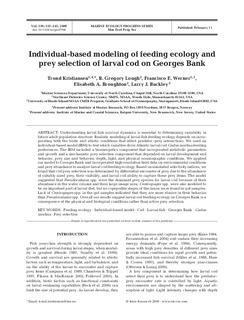Individual-based modeling of feeding ecology and prey selection of larval cod on Georges Bank
Journal article, Peer reviewed
Permanent lenke
http://hdl.handle.net/11250/108102Utgivelsesdato
2009-02-11Metadata
Vis full innførselSamlinger
- Articles [3012]
Originalversjon
http://dx.doi.org/10.3354/meps07796Sammendrag
Understanding larval fish survival dynamics is essential to determining variability in future adult population structure. Realistic modeling of larval fish feeding ecology depends on incorporating both the biotic and abiotic conditions that affect predator–prey interactions. We used an individual-based model (IBM) to test which variables drive Atlantic larval cod Gadus morhua feeding preferences. The IBM included a bioenergetics component that incorporated metabolic parameters and growth and a mechanistic prey selection component that depended on larval development and behavior, prey size and behavior, depth, light, and physical oceanographic conditions. We applied our model to Georges Bank and incorporated high-resolution field data on environmental conditions and prey abundance to analyze larval cod feeding ecology. Based on simulated selectivity indices, we found that cod prey selection was determined by differential encounter of prey due to the abundance of suitably sized prey, their visibility, and larval cod ability to capture these prey items. The model suggested that Pseudocalanus spp. were the dominant prey species for larval cod because of their abundance in the water column and their large image area. Centropages spp. were also modeled to be an important part of larval diet, but no copepodite stages of this taxon were found in gut samples. Lack of Centropages spp. in the gut samples indicated that they are more elusive in their behavior than Pseudocalanus spp. Overall our results suggest larval cod feeding ecology on Georges Bank is a consequence of the physical and biological conditions rather than active prey selection.
